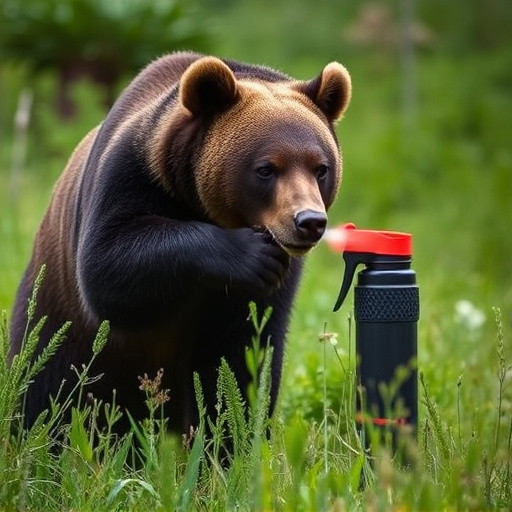Understanding the optimal range of bear spray (20-30 feet) is crucial for safety in Alaska's wilderness, influenced by product type, weather, and bear size. Correct usage involves aiming at the bear's face and eyes to temporarily disable it, allowing escape or de-escalation. No repellent offers 100% protection, so maintaining a safe distance from bears remains vital during outdoor activities in bear country. The best distance for maximizing bear spray effectiveness is between 20 to 30 feet.
Alaska’s rugged terrain demands knowledge of bear repellent range to ensure safety during outdoor adventures. This guide explores the factors that determine the maximum reach of bear spray, a vital tool in deterring aggressive bears. We’ll dissect how environmental conditions and spray techniques impact effectiveness, offering insights on maximizing the best distance for bear spray to make every excursion safer. From understanding spray patterns to mastering application methods, this article equips readers with crucial knowledge for navigating Alaska’s wilderness.
- Understanding Bear Spray Range and Effectiveness
- Factors Influencing Bear Repellent Maximum Range
- Maximizing the Distance and Impact of Your Bear Spray
Understanding Bear Spray Range and Effectiveness
Understanding the bear spray range and its effectiveness is crucial when venturing into Alaska’s wild terrain. The best distance for bear spray to be effective varies based on several factors, including the specific product, weather conditions, and the size of the bear encountering you. Typically, bear spray has a reach of around 20 to 30 feet (6 to 9 meters), but this can reduce in windy or cold conditions.
The key to maximizing its effectiveness is ensuring you use it correctly. Aim for the face and eyes of the bear, which are sensitive areas. The spray creates a temporary blindness and irritates the bear, allowing you time to retreat or defuse the situation. However, remember that no repellent can guarantee 100% protection, especially against aggressive or hungry bears. Always maintain a safe distance and be prepared for any eventuality when hiking or camping in bear country.
Factors Influencing Bear Repellent Maximum Range
The maximum range of a bear repellent, like bear spray, is influenced by several key factors. One of the primary considerations is the can’s nozzle and spray pattern. Different nozzles emit sprays in various directions and distances, with some designed for wider coverage and others for more focused, direct blasts. Wind conditions play a significant role too; a headwind can reduce the effective range significantly, while a tailwind might increase it.
Another crucial factor is the environment. In dense vegetation or rough terrain, bear spray may not travel as far due to the obstruction and dispersion caused by trees, bushes, and other natural barriers. Conversely, open spaces like plains or alpine areas allow for greater spray projection and can extend the effective range. Additionally, factors like temperature, humidity, and air pressure can impact the aerosolization of the spray, potentially affecting its dispersal and longevity in the environment.
Maximizing the Distance and Impact of Your Bear Spray
To maximize the distance and impact of your bear spray, it’s crucial to understand the best practices for application and the optimal range for effectiveness. The recommended distance for successful deterrence typically ranges from 20 to 30 feet (6 to 9 meters). This range allows you to deploy the spray accurately while ensuring that it reaches the bear’s eyes and nasal passages, the primary targets for irritation.
When using bear spray, aim high, aiming for the face and upper body of the bear. The spray should create a cloud that blankets the animal, disrupting its sense of smell and vision temporarily. Bear spray is most effective when used responsibly at the appropriate distance, giving you time to escape or reevaluate your situation without provoking an attack.
Determining the maximum range of a bear repellent, like Guard Alaska bear spray, is key to ensuring your safety in grizzly country. While there’s no single ‘best’ distance for effectiveness, understanding factors like wind, terrain, and spray pattern can help maximize its impact. By following best practices for application and usage, you can increase the likelihood of deterring bears at greater distances. Remember, knowledge and preparation are crucial when adventuring in bear habitat.
